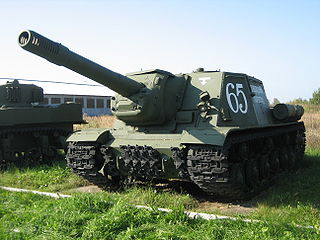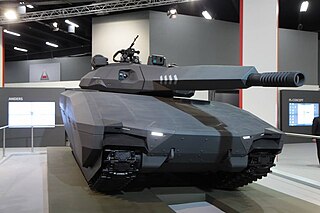
The T-64 is a Soviet second-generation main battle tank introduced in the early 1960s. It was a more advanced counterpart to the T-62: the T-64 served in tank divisions, while the T-62 supported infantry in motorized rifle divisions. It introduced a number of advanced features including composite armor, a compact engine and transmission, and a smoothbore 125-mm gun equipped with an autoloader to allow the crew to be reduced to three so the tank could be smaller and lighter. In spite of being armed and armored like a heavy tank, the T-64 weighed only 38 tonnes.

The BMP-1 is a Soviet amphibious tracked infantry fighting vehicle. BMP stands for Boyevaya Mashina Pyekhoty 1, meaning "infantry fighting vehicle, 1st serial model". The BMP-1 was the first mass-produced infantry fighting vehicle (IFV) of the Soviet Union. It was called the M-1967, BMP and BMP-76PB by NATO before its correct designation was known.

The ISU-152 is a Soviet self-propelled gun developed and used during World War II. It was unofficially nicknamed zveroboy in response to several large German tanks and guns coming into service, including Tigers and Panthers. Since the ISU-152's gun was mounted in a casemate, aiming it was awkward, and had to be done by repositioning the entire vehicle using the tracks. Therefore, it was used as mobile artillery to support more mobile infantry and armor attacks. It continued service into the 1970s and was used in several campaigns and countries.

The Leclerc tank is a main battle tank (MBT) built by Nexter Systems of France. It was named in honor of General Philippe Leclerc de Hauteclocque, who led the French element of the drive towards Paris while in command of the Free French 2nd Armoured Division in World War II. The designation "AMX-56" – while very popular – is incorrect.

The M48 Patton is an American first-generation main battle tank (MBT) introduced in February 1952, being designated as the 90mm Gun Tank: M48. It was designed as a replacement for the M26 Pershing, M4 Sherman variants and M46 Pattons used in the Korean War, and as the successor to the M47 Patton. Nearly 12,000 M48s were built, mainly by Chrysler and American Locomotive Company, from 1952 to 1961. The M48 underwent many design modifications and improvements during its production life. This led to a wide variety of suspension systems, cupola styles, power packs, fenders and other details among individual tanks.

The T-84 is a Ukrainian main battle tank (MBT), a development of the Soviet T-80 main battle tank introduced in 1976. The T-84 was first built in 1994 and entered service in the Ukrainian Armed Forces in 1999. The T-84 is based on the diesel-engined T-80 version, the T-80UD. Its high-performance opposed-piston engine makes it one of the fastest MBTs in the world, with a power-to-weight ratio of about 26 horsepower per tonne.

The Char 2C, also known as the FCM 2C, was a French heavy tank, later also seen as a super-heavy tank, developed during World War I but not deployed until after the war. It was, in total volume or physical dimensions, the largest operational tank ever made.

The FV4201 Chieftain was the main battle tank of the United Kingdom during the 1960s-1990s.

The T95 was an American prototype medium tank developed from 1955 to 1959. These tanks used many advanced or unusual features, such as siliceous-cored armor, new transmissions, and OPTAR fire-control systems. The OPTAR incorporated an electro-optical rangefinder and was mounted on the right side of the turret, and was used in conjunction with the APFSDS-firing 90 mm T208 smoothbore gun, which had a rigid mount without a recoil system. In addition, although the tanks were designed with a torsion beam suspension, a hydropneumatic suspension was fitted, and one of the tanks was fitted with a Solar Saturn gas turbine for demonstration purposes.

An autoloader or auto-loader is a mechanical aid or replacement for the personnel that load ordnance into crew-served weapons without being an integrated part of the gun itself. The term is generally only applied to larger weapons, such as naval weapons, tanks and artillery, that would otherwise have a dedicated person or persons loading them.

The T-44 is a medium tank first developed and produced near the end of World War II by the Soviet Union. It was the successor to the T-34, offering an improved ride and cross-country performance, along with much greater armor. Designed to be equipped with an 85 mm main gun, by the time it was fully tested the T-34 had also moved to this weapon. Both tanks offered similar performance, so introducing the T-44 was not considered as important as increasing T-34 production. Fewer than 2,000 T-44s were built, compared to about 58,000 T-34s. Although the T-44 was available by the end of the war, it was not used in any battle. It was 1 ton lighter than the T-34-85 and slightly faster. The T-44 was heavily influential on the design of the T-54/55 main battle tank, most notably the removal of side sloping, thick frontal armor, and a low profile. Also notable was the T-44-100, a 100 mm D-10T-armed prototype, which would be the same 100 mm gun mounted on the T-54/55, bar some minor changes.

The BA-64 was a Soviet four-wheeled armoured scout car. Built on the chassis of a GAZ-64 or GAZ-67 jeep, it incorporated a hull loosely modeled after that of the Sd.Kfz. 221. The BA-64 was developed between July and November 1941 to replace the BA-20 then in service with armoured car units of the Red Army. Cheap and exceptionally reliable, it would later become the most common Soviet wheeled armoured fighting vehicle to enter service during World War II, with over 9,000 being manufactured before production ended.

BTR-90 (GAZ-5923) is an 8×8 wheeled armored personnel carrier developed in Russia, designed in 1993 and first shown publicly in 1994. It is a larger version of the BTR-80 vehicle, fitted with a BMP-2 turret. Armour protection is improved compared with the BTR-80, giving protection from 14.5 mm projectiles over the frontal arc.

The SK-105 Kürassier is an Austrian light tank armed with a rifled 105 mm gun in an oscillating turret. It is estimated that over 700 have been produced.

The T92 Light Tank, or 76-mm Gun Tank, T92, was an American light tank developed in the 1950s by Aircraft Armaments. It was designed as an airborne/airdropped replacement for the heavier M41 Walker Bulldog while retaining the mobility, protection level, and firepower of the latter. The unveiling of the Soviet PT-76 amphibious light tank pointed out that the future US light tank should be able to swim as well. Making the T92 amphibious was deemed impractical and the light gun tank program was cancelled in June 1958.

The 2S25 Sprut-SD is a self-propelled tank destroyer or light tank developed and manufactured by the Volgograd Tractor Plant to meet the requirements of the VDV. In mid-2001, the Volgograd tractor plant revealed that the development of the 2S25 had lasted several years.

The MOWAG Shark is an armored personnel carrier produced by the MOWAG Motor Car Factory, Kreuzlingen, Switzerland.

PL-01 was a Polish light tank mockup created by OBRUM with support from BAE Systems, based on the Swedish CV90120-T light tank. The concept vehicle was first unveiled at the International Defence Industry Exhibition in Kielce on 2 September 2013.
Object 490A "Rebel" was a Soviet experimental main battle tank developed between 1981 and 1982. Only two prototypes were ever produced, neither of which were capable of firing due to time constraints. Neither of the vehicles were completed before their production was ceased.

The Object 770 was a prototype heavy tank designed by Pavel Isakov.


















